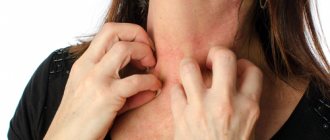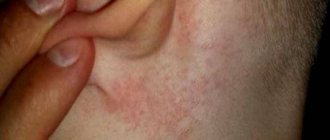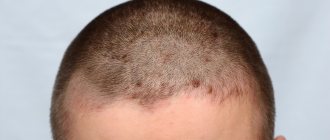Tuesday, February 25, 2020
Itching is an unpleasant symptom that can accompany many diseases of the penis. Some of the causes of itching of the penis require rapid treatment - the lack of treatment worsens the quality of life (shame, obstacle to sexual relations) and can lead to complications (lichenification, phimosis, and closure of the urethra). If you have increased thickening of the penis, you should consult a dermatologist or urologist.
Why might the penis be itchy?
Interested in the question: “Why does the penis itch?” - we answer. The causes of itching of the genitals can easily be external irritants - hypothermia and overheating of the penis or scrotum, chemicals and synthetic underwear.
In some cases, symptoms may result from exposure to potent topical medications.
Sometimes itching appears due to disturbances in the functioning of internal organs. For example, as a result of blood diseases (anemia, leukemia, lymphogranulomatosis) or as hepatitis, kidney disease, endocrine system disorders, cancer.
A situation where very severe itching of the head of the penis is accompanied by external changes may be the result of an allergy.
Physiology of urine output
Urination is necessary to remove unnecessary metabolic products and harmful chemical compounds from the body.
Urine itself is formed in the kidney tissue as a result of blood filtration: nephrons successively remove ballast substances from the blood vessels and return necessary components, such as proteins and salts, to the bloodstream. More than one hundred liters of primary urine can be formed per day, but as a result of final filtration, 800-1500 milliliters of liquid per day are removed from the body. The excretory fluid formed in the kidneys penetrates into other parts of the excretory system for accumulation and gradual removal from the body. Approximately 500 ml of urine can be deposited in the bladder, and a person begins to feel the need to urinate when a quarter of the organ’s volume is filled. The signal received from the brain relaxes the sphincter and promotes the removal of fluid from the body through the urethra. In men, part of the urethra passes through the prostate gland, so prostate pathologies can cause dysuria.
Dermatitis
Dermatitis - what is it? Diseases such as allergic eczema, which can cause itching of the penis. These include the diseases described below.
- Contact dermatitis - manifests itself as reddened, well-demarcated areas of erythema associated with inflammation and peeling. This can occur after the skin of the genital organ comes into contact with materials that increase its sensitivity, such as latex, which is used to make condoms. How to get rid of it? The patient is treated after complete elimination of the possibility of contact with the irritant.
- Irritation caused by eczema - symptoms of pustules and papules on the penis with the presence of ascites, with the formation of crusts. The cause of the disease is excessive use of hygiene measures (for example, cosmetics, soap) and too frequent bathing and drying. In treatment, the most important thing is to stop the agent that is causing the symptoms. In order to cure complaints, local glucocorticosteroid drugs can be used, and antihistamines can be used to relieve itching.
- Eczema is caused by dehydration - symptoms include very intense itching. The disease causes dry skin and often occurs in older people.
Infections
One of the most common diseases of the penis is a fungal infection. The cause of mycosis of the penis is an infection of the genital skin with fungi of the species Candida albicans. It is more common in people with immune disorders, chronic antibiotic use, diabetes and cancer. Mycotic changes are promoted by: poor hygiene of the perineal area and excessive use of cosmetics in these areas. The infection can be transmitted from a partner/sexual partner, sanitary equipment (swimming pools, toilets), towels and other objects with a favorable environment for the development of fungi. Symptoms of the disease:
- the appearance of red papules and pustules on the penis;
- itching and redness;
- A white coating with a specific odor appears on the head.
In addition, the disease is usually accompanied by swelling and pain. Treatment uses topical and oral antifungal drugs.
What is the difference between balanoposthitis and balanitis?
The similarity in the names of these diseases is not accidental.
Balanoposthitis is an inflammation of the glans penis involving the foreskin.
It develops initially or as a complication of balanitis.
For the development of this condition, as a primary one, the influence of a number of individual factors is necessary.
The narrow foreskin prevents the full release of the head of the penis.
This phenomenon is called phimosis.
It can be physiological and pathological.
Pathological narrowing occurs after injuries, scars, and swelling.
In the folds that form the foreskin, bacteria accumulate and inflammation begins.
Circumcision is separately identified as a cause of development.
With this surgical intervention, an entry gate for infection is formed.
If the patient neglects the doctor’s recommendations and asepsis, this leads to the development of an inflammatory process.
The symptoms of balanoposthitis are identical to the manifestations of balanitis.
Other non-infectious causes
Psoriasis is usually associated with the skin around the head, torso, or extremities, but it is also the most common inflammatory condition of the genital area. The diagnosis involves the presence of psoriatic plaques - well separated from the surrounding tissues, with the presence of plaques and scales, accompanied by peeling. The diagnosis is usually straightforward - psoriatic lesions in most patients are also present in other parts of the body. Treatment is typical for psoriasis: highly effective corticosteroids and vitamin D derivatives are used.
Lichen sclerosis of the genitals is a serious disease of the skin of the genital organ in men, more often found in those who have not been circumcised (while maintaining the foreskin). At the beginning it is accompanied by the formation of white lumps on the surface of the penis, which turn into atrophic, sclerotic plaques. During this disease, additional cracks, blisters with bloody contents, erosions and even ulcers may occur. Often the symptoms of the disease are itching, burning and bleeding of the penis when urinating. Complications include phimosis and paraphimosis (urethral stricture can block the flow of urine). The disease is also dangerous due to the possibility of developing cancer based on it. Treatment requires close medical supervision. Most often, strong local glucocorticoids are used, but immunosuppressive drugs are sometimes necessary. Patients are advised to undergo circumcision.
Erythema is a drug-induced change that can lead to the formation of lesions in the genital organ with the appearance of erythematous plaques, mainly in the glands. Often accompanied by itching of the penis. The reason why the disease can develop is an adverse reaction to drugs (for example, barbiturates, nitroimidazoles, tetracycline). The diagnostic examination is a biopsy with histopathological analysis of the collected material.
Diagnosis of itching of the penis
Some symptoms of itching may go away on their own, without the need to visit a doctor. For example, itching due to ingrown hairs goes away within 7 days, or itching, inflammation and redness from contact dermatitis can be eliminated with hygiene and changing the type of underwear (to cotton and loose ones). But there are also diseases that will only get worse without drug intervention.
The doctor can determine the cause of the disease during the initial examination. If necessary, the following may be prescribed: smears from the male genital organ, scrapings of peelings, blood and urine tests, ultrasound of the pelvic organs. In each individual case, a specific type of diagnosis is prescribed.
Complications of balanitis
In the absence of adequate therapy, the patient may develop negative consequences.
The infectious process may spread to the pelvic organs.
Cystitis, pyelonephritis or glomerulonephritis occurs.
A prolonged inflammatory process leads to disruption of innervation.
As a result, the sensitivity of the head of the penis decreases.
Contact with an eroded surface or ulcerative defect of an anaerobic infection leads to the development of gangrene.
This dangerous complication can result in amputation.
With a prolonged inflammatory process, the foreskin narrows and secondary phimosis appears.
Moreover, scarring can spread to the urethra and interfere with the normal act of urination.
Treatment
Most diseases can be treated by proper hygiene and wearing loose cotton underwear. If no improvements were noted within 3-5 days, the attending physician may prescribe medication.
Drug treatment
Drug treatment usually includes:
- Antibiotic ointments (eg, Mupirocin or Clindamycin): effective for diagnosed bacterial infections.
- Antifungal ointments (for example, Terbinafine, Clotrimazole or Nystatin): prescribed when diagnosing diseases caused by fungal infections.
- Ointments of the corticosteroid group (for example, hydrocortisone): effectiveness is observed in any cases of itching and other unpleasant symptoms in the male genital area.
If the disease does not respond to conservative treatment, it is recommended to undergo additional tests for an allergic reaction, which can be triggered by personal hygiene products, food, and even ointments used for treatment. If an allergy is confirmed, it is important to remove the allergen, and only then continue treatment.
After successful treatment, you need to continue to observe the rules of personal hygiene, avoid products that cause skin irritation, and avoid casual sexual intercourse without protective equipment.
Traditional methods
| Type of folk remedies | Recipes |
| Tinctures | Place three tablespoons of blackcurrant leaves in an enamel bowl. Pour boiling water over everything (2 cups). Infuse and drink. The drink has anti-inflammatory, analgesic and diuretic effects |
| Crush parsley seeds (1 teaspoon), add a liter of cold water. Leave to steep for up to ten hours. Take three tablespoons every three hours. Helps relieve itching and inflammation | |
| Soda solution | Helps cope with fungal infections, ingrown hairs, and flaking. Softens the skin and has a disinfecting effect. After complete drying, it dries out the fungus-affected areas of the skin. Mix baking soda and water in proportions of 1 part baking soda to 5 parts water. It is important, after each use of the solution, to thoroughly wash the container and use disposable sponges and gloves, change underwear frequently and wash at high temperatures (it is advisable to iron after each wash) |
| Oils | Oil solution of chlorophyllipt, birch bud oil, calendula |
| Baths | Baths will help relieve unpleasant symptoms and provide a healing effect. Duration of administration is 15 minutes daily. You can add chamomile, tincture of birch and poplar buds, rosanol, and calendula to the bath. It is useful to make baths with sea salt - for 1 liter of water, 1 tablespoon of salt. |
You can use traditional methods of treatment only after consultation with a urologist, proctologist or dermatologist. Self-medication can provoke an exacerbation of the disease.
Prevention
Preventive methods for diseases of the genital organ in men include:
- genital hygiene: 2 times daily;
- daily change of underwear;
- sexual life with a regular partner (frequent changes of sexual partners should be accompanied by the use of contraception);
- Cotton underwear, avoid synthetics - they provoke excessive sweating.
Itching is a certain reaction of the body’s skin to various diseases that occurs in a certain area of the body. The most common reason for itching in the area of the penis and its tip (head) is failure to maintain regular intimate hygiene, as well as regular use of synthetic underwear.
Remember, timely seeking medical help will help determine the presence of the disease in time and eliminate not only the symptoms, but also the cause. Important: self-medication can aggravate the situation and lead to serious diseases such as cancer and infertility.
How and with what they are treated
Outpatient treatment is mainly used to treat inflammation of the glans penis.
A patient with a mild form of the disease receives an appointment that he will have to comply with.
To monitor therapy, the attending physician schedules regular visits.
He will evaluate the result and prescribe additional tests if necessary.
Severe disease is treated in a hospital setting.
The patient requires constant monitoring and supervision of medical personnel.
Medicines are selected taking into account the cause of the disease.
The duration of the course of treatment will depend on them.
If the patient has a regular sexual partner, then the examination must be done together.
This will allow us to identify possible carriage or latent course of the disease.
It also helps prevent re-infection or relapse.









